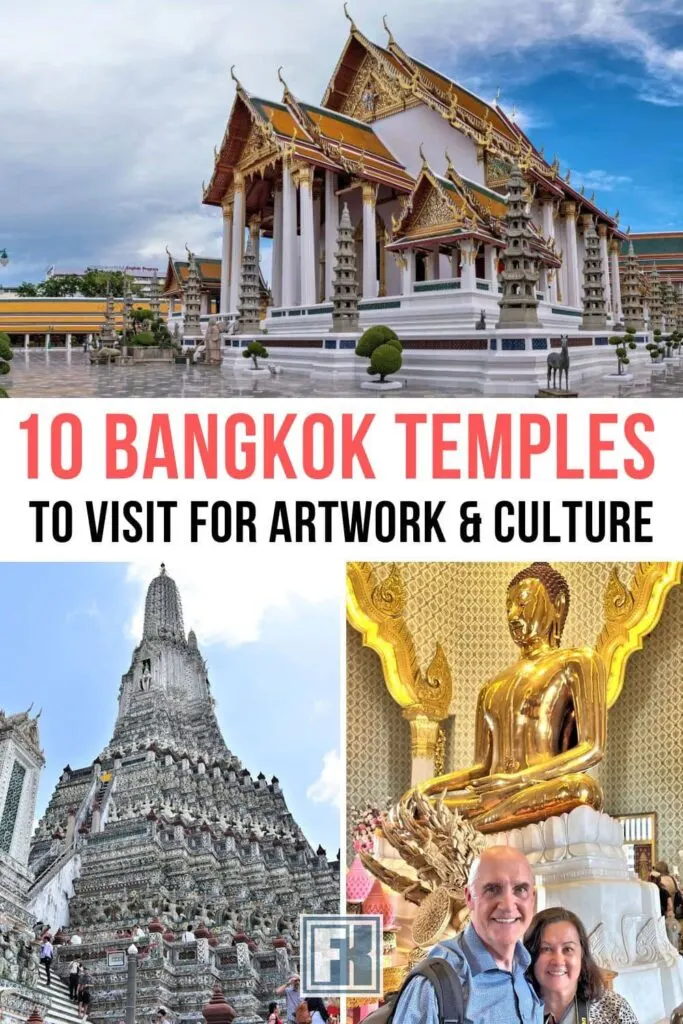
Bangkok, Thailand’s capital, has over 400 temples, primarily reflecting Buddhism. These temples are a significant draw for tourists and Thai people. While you can’t visit them all, I’ve showcased the ten Bangkok temples to explore for intricate artwork, serene ambiance, and spiritual practices.
These temples, known locally as ‘Wats,’ showcase diverse architectural styles. From the iconic Wat Arun to the majestic Wat Phra Kaew, each temple offers a unique glimpse into Thailand’s rich religious and cultural heritage.
Not only do they differ in design, but they also vary in historical significance. When visiting, Women must cover their shoulders and knees and remove their shoes before entering temple buildings. I found most temples didn’t force the rule, but the Grand Palace did.
Visitors to Thailand’s capital city can reach temples by tuk-tuk, a traditional Thai transportation. If you’re arriving by cruise ship to the port of Laem Chabang, you’ll have a 2 to 2-1/2 hour journey to Bangkok, depending on traffic.
The popular temples aren’t close together so have a transportation plan to get there or purchase an excursion that visits several in a day.
Bangkok Temple Tours
- Bangkok Temples City Tour with a guide and visits three temples
- Grand Palace & Bangkok Temples includes a tour of the spectacular Grand Palace and four temples
- Temple Tour of Bangkok tour three temples and enjoy a long boat cruise down the Chao Phraya River
Here are some Thai temples to enjoy on your Bangkok itinerary.
Wat Phra Kaew
- Location: The Grand Palace | Opening hours: Daily 8:30 am to 3:30 pm (closed during Royal ceremonies)
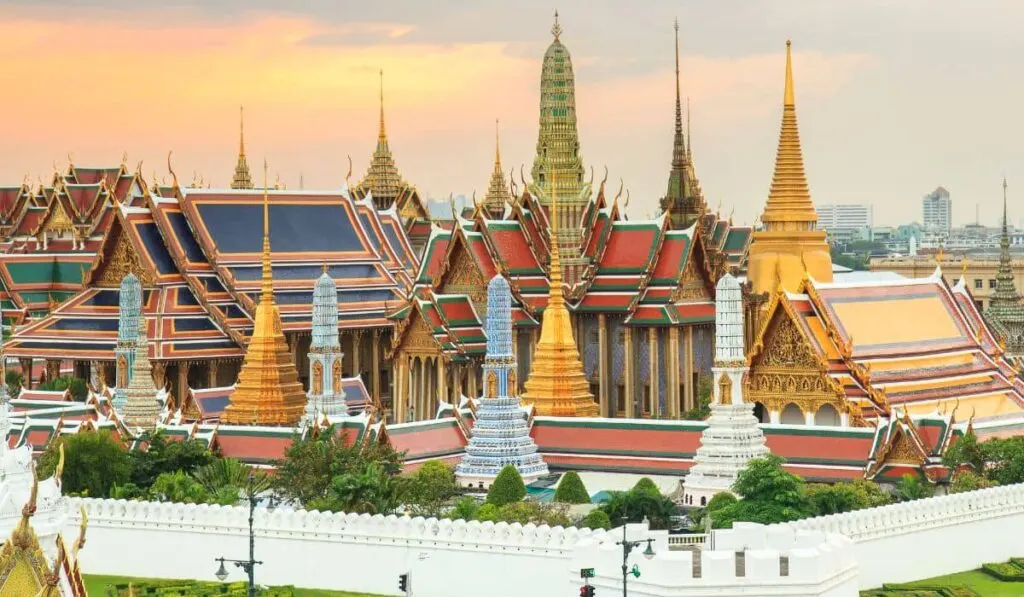
Known as the Temple of the Emerald Buddha, Wat Phra Kaew is Thailand’s most sacred Buddhist temple. You’ll find this famous temple in the historic center of Bangkok, within the grounds of the Grand Palace, you’ll need to abide by the dress code to visit.
Rama I, the first Chakri dynasty king, constructed the temple in 1783, and it’s still used by the monarch and royal family today.
The extensive temple complex comprises several richly decorated buildings, many with gold leaf.
Inside the Ubosot (Ordination Hall), you’ll find the revered Emerald Buddha statue carved from a single block of jade. Only the King and the crown prince can touch the statue when representing the King.
While the Emerald Buddha might be the draw for this attraction, its surrounding structures and temple guardians embody different influences.
For instance, Phra Si Rattana Chedi is a golden stupa in a bell shape showcasing Sri Lankan influence. In contrast, Ho Phra Khanthararat combines Thai and Khmer architectural styles with distinctive yellow and blue ceramic tiles.
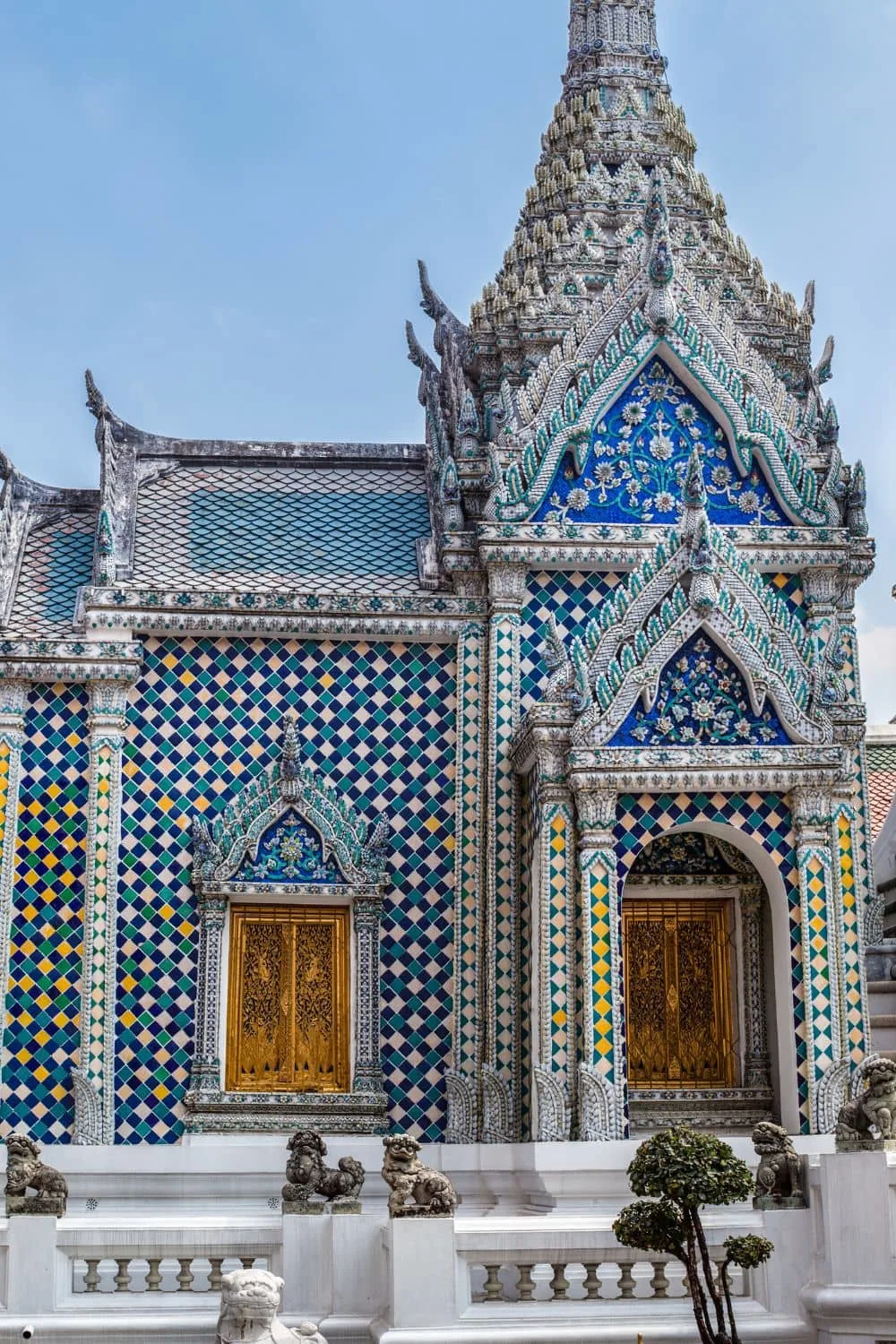
Visitors to Wat Phra Kaew might find it (dare I say) a bit garish, but I found its architectural style stunning. The expanse of gold, Buddha images, and attention to detail left me speechless.
If you’re planning to visit the complex of the Grand Palace and Wat Phra Kaew, expect to spend the better part of a day exploring every nook and cranny.
Wat Arun
- Location: 158 Thanon Wang Doem | Opening hours: Daily 8 am to 6 pm

Dominating the Bangkok skyline, Wat Arun, or the Temple of Dawn, is renowned for its distinctive architectural style inspired by Khmer design. The Buddhist temple dates to the 17th century. However, its iconic spire was added during the Ayutthaya period in the early 19th century.
Standing at about 70 meters, the central prang (tower) symbolizes Mount Meru, the center of the world in Buddhist cosmology. While its rocket shape mesmerizes from a distance, you must see it up close to admire the detail.
In contrast to Wat Phra Kaen, colorful porcelain and seashells adorn Wat Arun’s exterior. The floral mosaics are a visual masterpiece, and I was amazed they are well preserved.
You can climb the steep steps of the prang to the first level for panoramic views of the Chao Phraya River and Bangkok. The step risers are very high, making it hard to climb. With no handrail, I found coming down was quite hazardous.
The temple grounds feature smaller towers, statues, and pavilions, reflecting traditional Thai architecture.
Visiting during sunrise or sunset offers a breathtaking view as the temple reflects the golden light. However, to get those iconic sunset photos, head across the other side of the river to capture the red sky behind the temple.
The entrance fee costs a mere 100 baht, and you can rent traditional Thai clothing for an additional 150 to 250 baht. Local Thai people participate in this popular activity, crowding the narrow walkway on the temple with their photographers in tow.
If you plan to visit Wat Arun, reaching the temple by boat is faster and cheaper than a tuk-tuk.
Wat Benchamabophit
- Location: 69 Thanon Si Ayutthaya | Opening hours: Daily 6 am to 6 pm
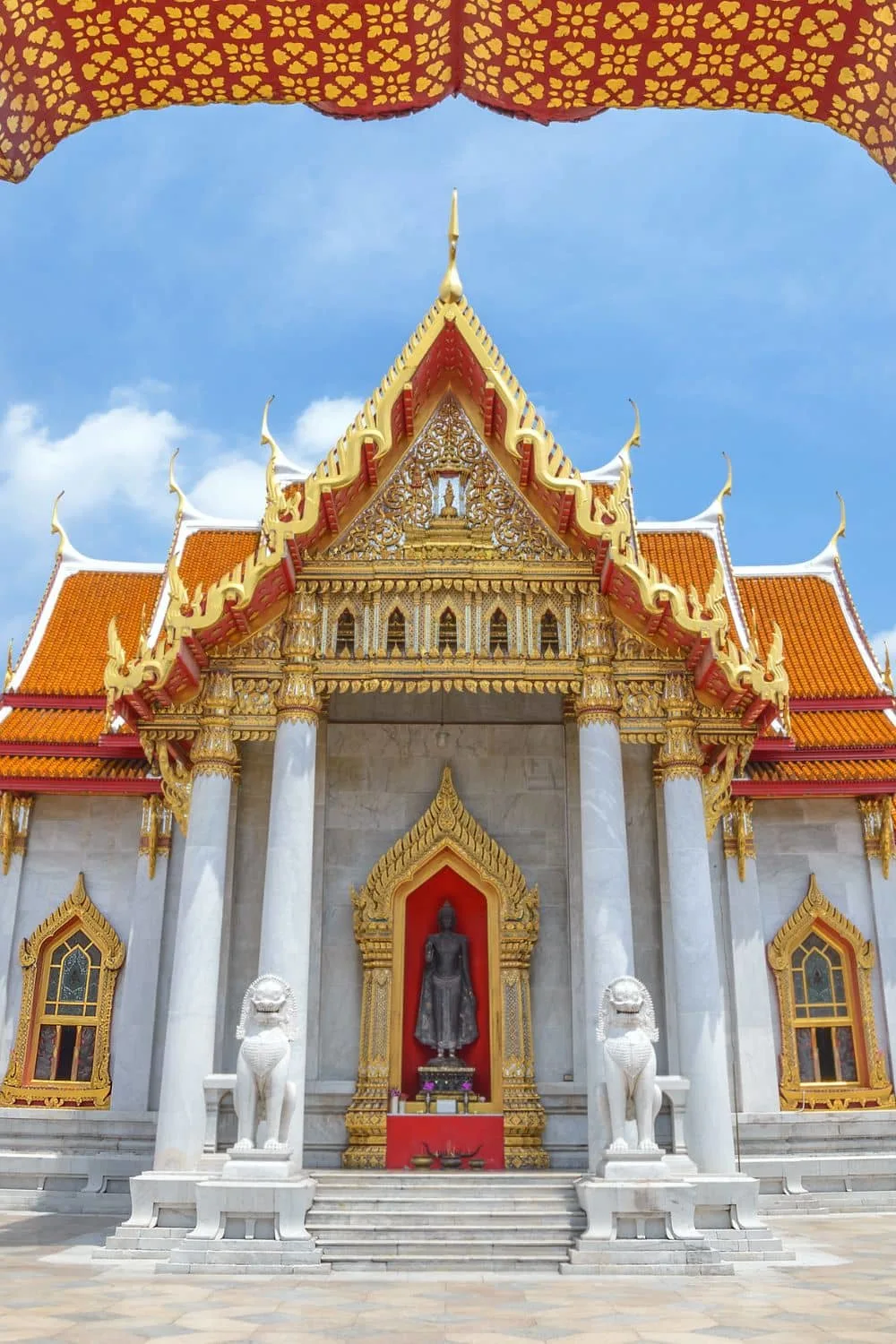
Another one of Bangkok’s notable Buddhist temples is Wat Benchamabophit, also known as the Marble Temple. Built in 1899 under King Rama V’s reign, it reflects a fusion of Thai and European styles.
Its unique architecture, featuring Italian marble, sets it apart from traditional Thai temples, usually made of wood and tiles. Visitors typically spend around one hour exploring Wat Benchamabophit. It’s smaller than Bangkok’s famous Grand Palace or Wat Pho, making it more manageable.
On the temple grounds, the Ubosot, or Ordination Hall, showcases intricate crossbeams and a multi-tiered roof, common in Thai design. A notable European influence is seen in its stained glass windows, which add color and artistic character, contrasting with the temple’s traditional Thai elements.
These windows, featuring Buddhist teachings, are uncommon in Thai temples, highlighting Wat Benchamabophit’s historical openness to global influences.
Inside, a Sukhothai-style Buddha image named Phra Buddhajinaraja is the main attraction. The compound includes a cloister with 52 Buddha statues, each displaying different mudras (hand gestures), offering a comprehensive view of Buddhist art styles.
Wat Benchamabophit’s main prayer hall features the world’s largest bronze Buddha image at 9.55 meters, Phra Buddha Chinnarat.
The temple’s tranquil gardens and ponds add to its charm, creating a peaceful atmosphere amidst Bangkok’s bustling streets. Since this temple opens earlier than others, you can enjoy it with cooler temperatures.
Wat Mangkon Kamalawat
- Location: 423 Charoen Krung Road | Opening hours: Daily 8 am to 5 pm, except Sunday when it’s open until 6 pm

This one makes the list for its distinct Chinese architectural style, with different atmospheres and rituals. Built in 1871, Wat Mangkon Kamalawat, also known as the Dragon Lotus Temple, is a prominent Chinese-Buddhist temple.
Unlike typical Thai temples exhibiting ornate, pointed roofs and intricate, golden designs, Wat Mangkon Kamalawat features traditional Chinese structures. Colorful Chinese dragons sit on the roofs, and the Chinese art adorns the walls.
The temple’s design reflects the influence of Chinese immigrants in Bangkok. Inside, you’ll find a series of halls, just as richly decorated. These halls house various deities from Chinese folklore and Buddhist tradition.
The Chatulokkaban statues represent the world’s four guardians, each four meters tall and wearing warrior clothes. They hold a parasol, pagoda, snakehead, and mandolin, symbolizing protection.
Everywhere I looked, intricate carvings, murals, and statues filled the temple, providing a visual feast for my eyes. The main hall features a golden Buddha, surrounded by other deities, showing the fusion of Buddhist and Chinese spiritual practices.
Visitors can see worshippers engaging in different rituals, often involving incense and paper offerings. The temple is known for hosting important festivals, such as the Chinese New Year and the Vegetarian Festival, attracting large crowds.
Wat Traimit
- Location: 661 Charoen Krung Road | Opening hours: Daily 8 am to 5 pm
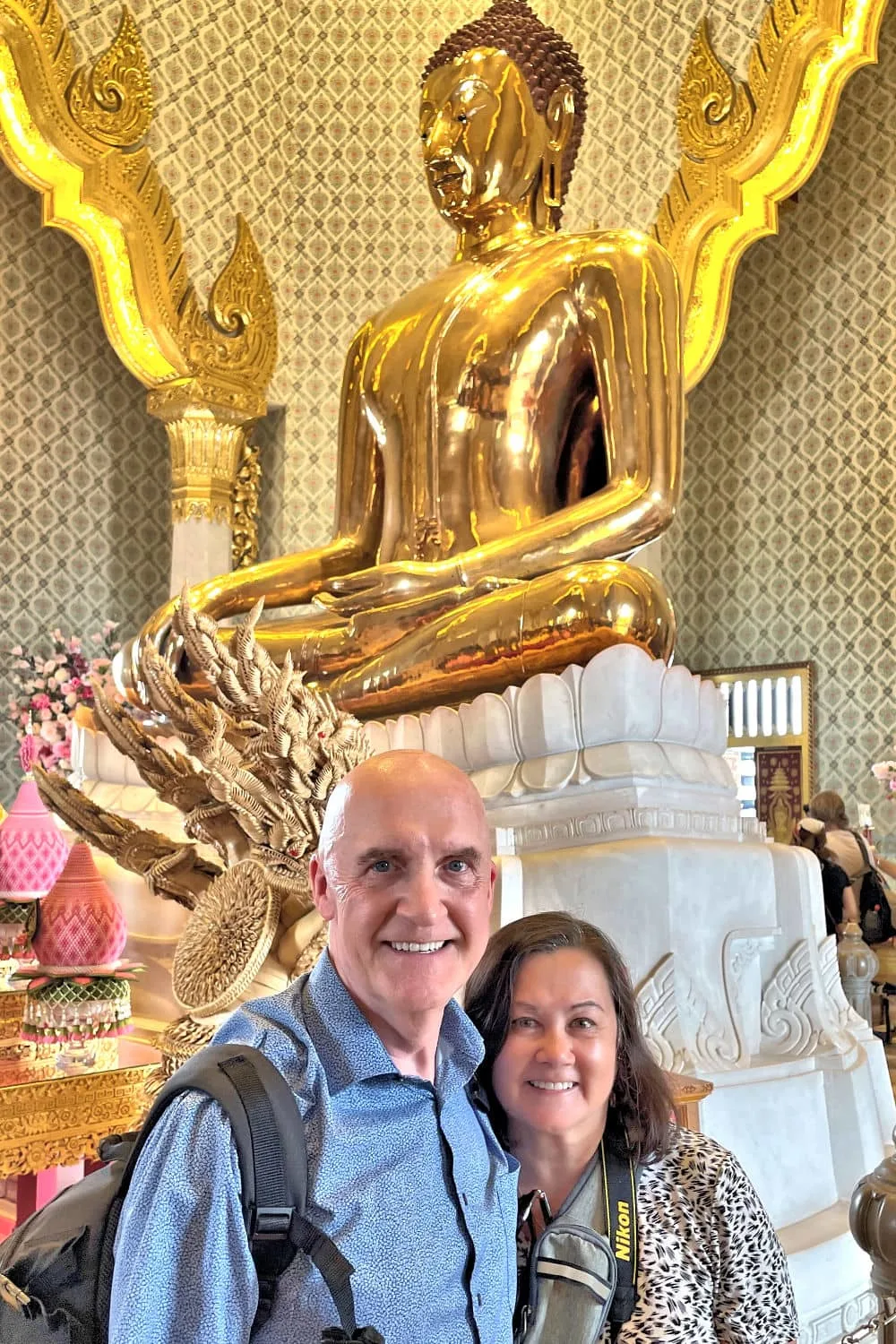
Wat Traimit, also known as the Temple of the Golden Buddha, houses the world’s largest solid gold Buddha statue. This 10-foot-tall statue, weighing approximately 5.5 tons, dates back to the 13th and 14th centuries.
At an estimated value of USD 360+ million, I was pretty excited I got this close to 1/3 billion dollars!
Built in the 1930s, Wat Traimit is relatively new and doesn’t have the wow factor of other historic Thai temples. However, it stands out due to its modern design and the immense value of the gold Buddha.
The temple is smaller than major temples like Wat Pho and Wat Arun but is significant for its unique artifact. Initially, the golden Buddha was covered in plaster to conceal its true worth. When it was moved to its present location in 1930, the plaster cracked, revealing its golden undertone.
Wat Traimit stands out for its Sukhothai art style, a crucial part of Thai history. Buddha images feature long faces and slender limbs, and the head usually has a flame-shaped growth above a skull bump.
The second floor of Wat Traimit contains an exhibit on Bangkok’s Chinese community history. The third floor has a museum detailing the Golden Buddha’s history, construction, and journey to Wat Traimit.
The Golden Buddha sits on the fourth floor, but you can use the elevator if you have limited mobility. Here, you’ll also see a few large bells. Devotees ring them, which is said to drive away evil spirits.
While I couldn’t ring these larger bells, I happily rang the row of smaller bells nearby.
Wat Pho
- Location: 2 Sanam Chai Rd | Opening hours: Daily 8 am to 6:30 pm

Also known as the Temple of the Reclining Buddha, Wat Pho has one of Bangkok’s oldest and largest temple complexes. Built in 1788, it predates the founding of Bangkok as the capital.
The temple exemplifies the Thai architectural style, characterized by steep roofs, intricate details, and vibrant colors. It stands out with its grandeur and size compared to other Thai temples.
The temple’s most famous feature is the 46-meter-long Reclining Buddha statue. Unlike the solid gold Buddha at Wat Traimit, this one is gold-plated, although that element didn’t distract from its grand appearance.
When viewing this massive statue, be sure to check out its feet. Its feet are made with mother-of-pearl, contrasting the golden body.
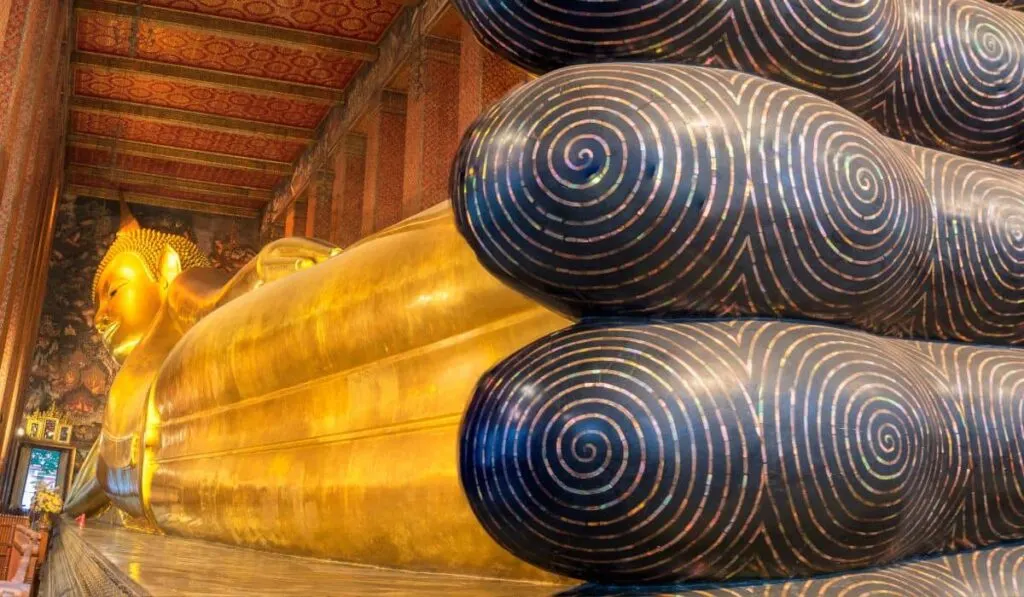
Around Wat Pho, I viewed countless Buddha images, which are said to be over a thousand. In fact, it houses the largest collection in Thailand.
Apart from its religious significance, Wat Pho is a center for traditional Thai medicine and massage. It’s regarded as Thailand’s first public university, teaching conventional Thai medicine and massage. This makes it a unique cultural and educational site.
Had I not been on an organized tour, I would have jumped at the chance to purchase one of those massages.
Sri Maha Mariamman Temple
- Location: 2 Silom Road | Opening hours: Mon to Thurs 6 am to 8 pm, Fri till 9 pm, and weekends until 8:30 pm

If you want to view a non-Buddhist temple, head to Sri Maha Mariamman Temple. This notable Hindu temple, built in 1879, has a different architectural style, distinctively South Indian.
The temple’s façade is typical of Hindu structures, vibrant and elaborate. It features a multitude of Hindu deities, which is a hallmark of Dravidian architecture. This differs from Thai temples, which typically showcase pointed roofs and golden spires.
If you’ve visited Singapore, you’ll find a similar temple with the same name.
The temple’s central deity is the goddess Mariamman. She is featured with many arms, representing her power to protect against diseases and misfortune.
Inside, you’ll find a rich array of statues and shrines dedicated to various Hindu gods and goddesses. The temple is also known for its annual Navratri festival, attracting devotees from all over.
A significant feature of the Sri Maha Mariamman Temple is the intricately carved gopuram (tower), a common element in South Indian temples but rare in Thailand. This tower is adorned with colorful figures of gods and mythical creatures, creating a visually stunning entrance.
Visitors to the temple can see traditional Hindu rituals and ceremonies, offering a unique spiritual experience in the heart of Bangkok. While Sri Maha Mariamman Temple sits in an area with few attractions, tourists flock there for cheap food, night markets, and wicked nightlife.
Wat Witsanu is another good Hindu temple worth visiting, although less impressive than Sri Maha Mariamman.
Wat Ratchanatdaram
- Location: 2 Maha Chai Rd | Opening hours: Daily 8:30 am to 9 pm

Yet another Buddhist temple, Wat Ratchanatdaram, makes this list for its number of iron spires – 37! Built in 1846 under King Rama III, it stands out with its distinct architectural style.
Unlike typical Thai temples, it features a metal castle called Loha Prasat. Indian and Sri Lankan designs inspire this structure. The temple’s 37 metal spires symbolize the 37 virtues of enlightenment in Buddhism.
The temple lacks the usual elaborate, colorful details of Bangkok’s most famous temples. Instead, it showcases a more austere, metal-oriented, almost Gothic appearance, which I prefer.
You can explore various aspects of the temple, from the Buddha images on the ground level to the meditation area at the top. As you ascend, the view of Bangkok’s old city becomes increasingly panoramic.
Less visited than better-known temples, this one leans more toward sacred service than a tourist attraction. Nevertheless, this one delivers if you’re seeking a cultural trip and a chance to see monks going about their everyday lives.
After the temple, explore the neighboring area. Surrounding the temple grounds are markets and traditional Thai eateries, enhancing the cultural experience.
Wat Saket
- Location: 344 Thanon Chakkraphatdi Phong | Opening hours: Daily 7:30 am to 7 pm

Constructed in the Ayutthaya era next to the Saen Saep Canal, Wat Saket’s origins trace back to the mid-18th century. Also known as Wat Saket Ratchawora Mahawihan, is renowned for its unique architectural style and historical significance.
The Golden Mount distinguishes this Bangkok temple, a man-made hill crowned with a gleaming golden chedi. Due to its famed feature, some call it the Temple of the Golden Mount.
Unlike other Bangkok temples, Wat Saket’s architecture blends Thai and European styles. Its designs and religious motifs showed Thailand’s artistic heritage. Visitors can explore the chedi, murals of Buddhist teachings, and various Buddhist statues.
The highlight was Bangkok’s panoramic view from the top of the Golden Mount. While visiting the temple requires no fee, there’s a small fee if you want to hike to the Golden Mount. Be warned, there are 300+ stairs to reach it.
While trees and jungle-like foliage shade the temple’s base, the trek to the peak provides little shade. To break up the journey, giant gongs and an army of bells invite you to bang and ring while making a wish.
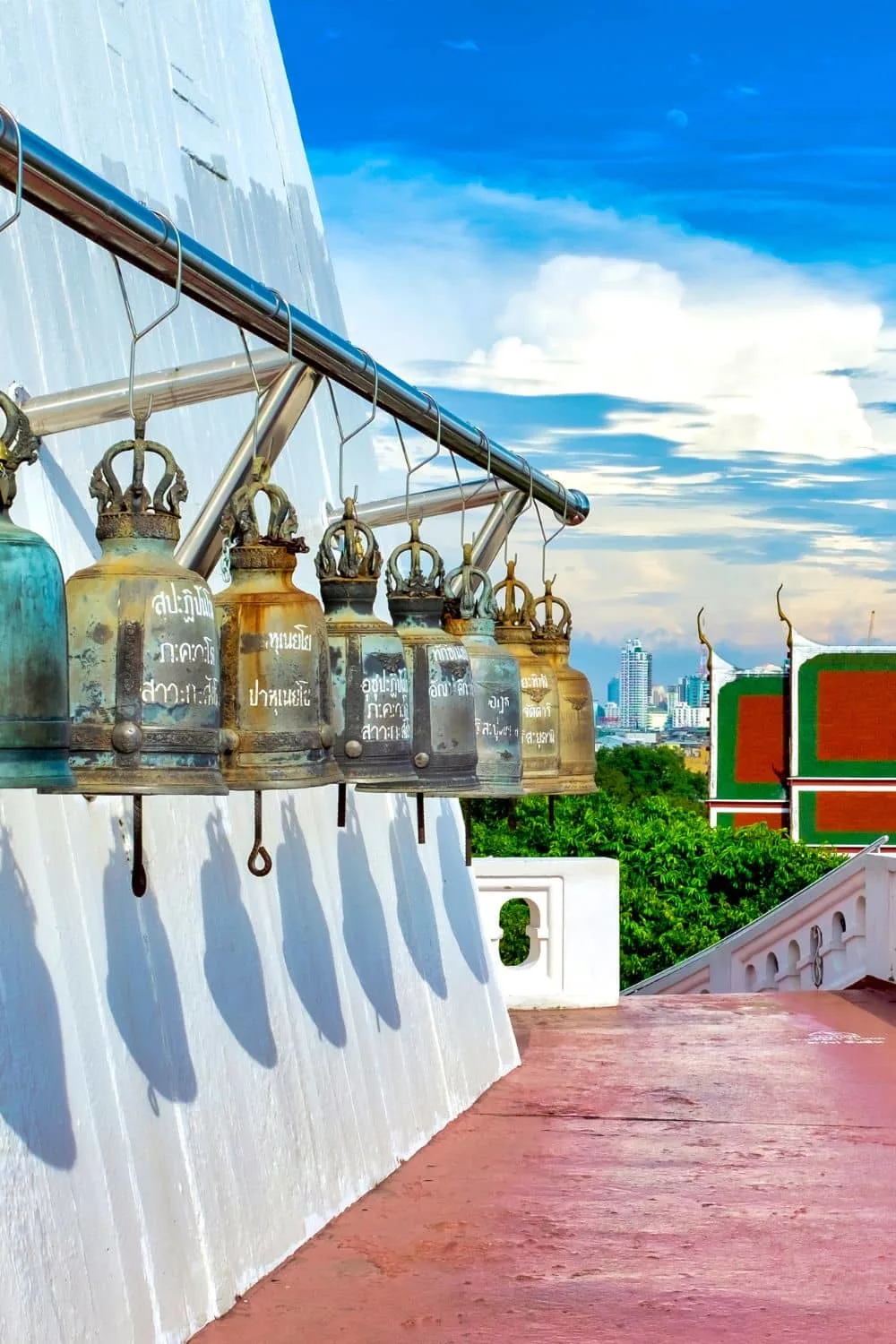
I savored the city’s skyline after climbing 300+ steps to the peak. If you’re worried about the climb, don’t fret; there are plenty of resting spots along the way.
If you visit in November, you’ll have a chance to enjoy Wat Saket’s temple fair. The complimentary event attracts locals and tourists to experience traditional Thai culture.
Wat Suthat
- Location: 146 Bamrung Mueang Rd | Opening hours: Daily 8 am to 8 pm
Another classic Buddhist temple, Wat Suthat, attracts visitors to see its giant red swing at the temple’s entrance. A striking feature, the 25-meter tall wooden swing, was constructed in front of a shrine and became a symbol of the city after it was moved.
Wat Suthat was built in the early 19th century during King Rama I’s reign and is a classic example of the Rattanakosin style. This style blends traditional Thai design with Khmer and Chinese influences.
The temple’s main feature is the impressive ordination hall. It’s renowned for its size and the beautiful murals that cover its walls. These murals depict scenes from Buddha’s life and traditional Thai life, offering a glimpse into Thailand’s past.
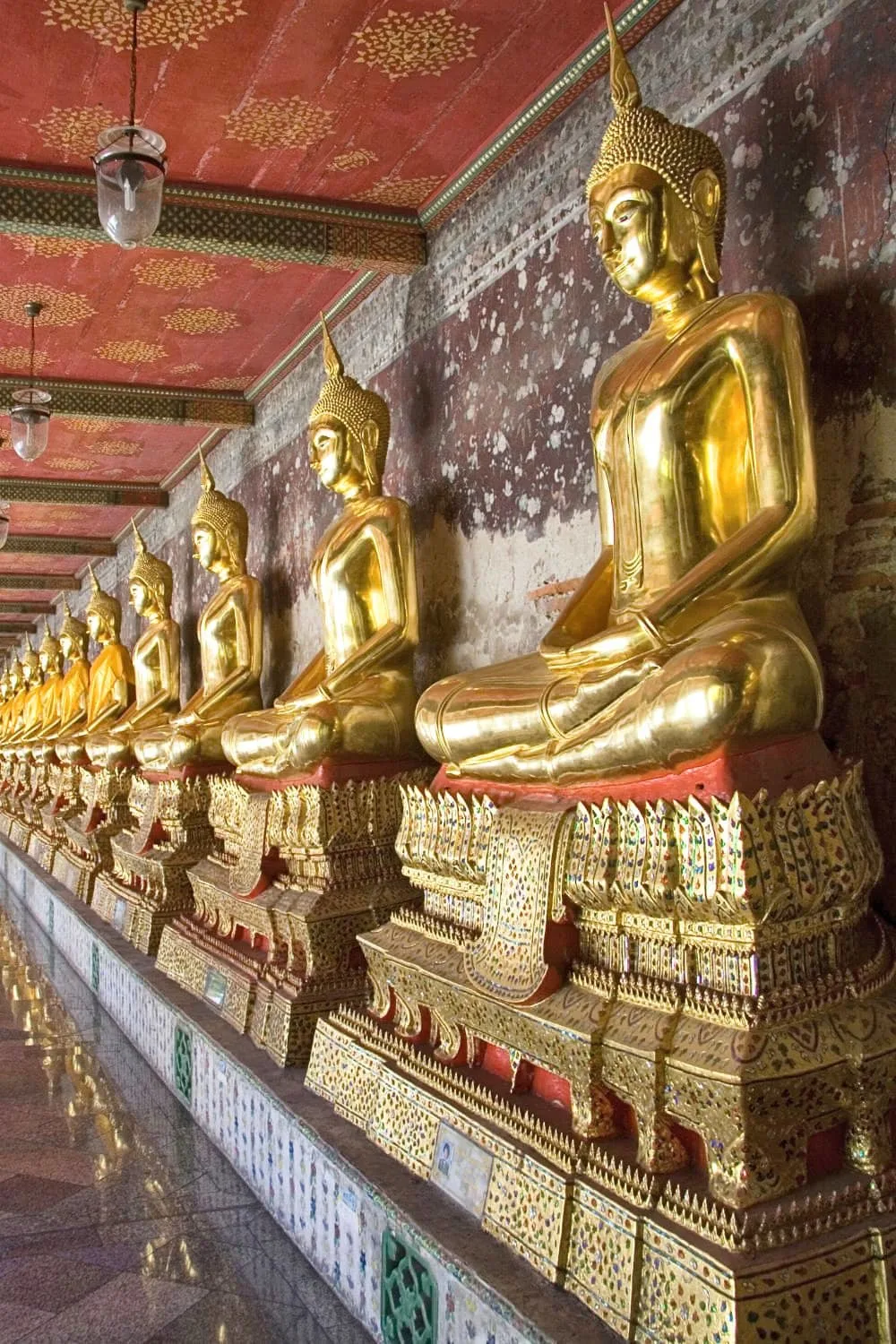
Spanning 10 acres, the temple complex is vast and invites exploration. You can admire a magnificent image of Buddha, Phra Sri Sakyamuni, measuring eight meters tall inside the temple.
Brought from Sukhothai, it adds historical value to the temple. Surrounding the main hall are 156 Buddha images, adding to the temple’s spiritual ambiance.
The temple’s roof is an architectural marvel. It’s adorned with intricate carvings and colorful ceramic tiles, reflecting Thai craftsmanship. The gable is decorated with hand-carved wooden figures, showcasing the skill of Thai artisans.
Visitors can also explore the temple’s cloister. It contains more than 150 Buddha images in various poses, each telling a different story from Buddhist teachings.
Final Thoughts
With over 40,000 temples in Thailand, it’s hard to visit this Asian country without visiting at least one. As a top destination in Thailand, Bangkok invites visitors to view some of its oldest temples.
However, traveling beyond Thailand’s capital city provides an opportunity for more exploration. Wat Phra That Doi Suthep and Wat Chedi Luang are popular tourist attractions in Chiang Mai.
No matter which Wat you plan to explore, you’ll leave with an appreciation for local culture, unique architecture, and religious heritage.
